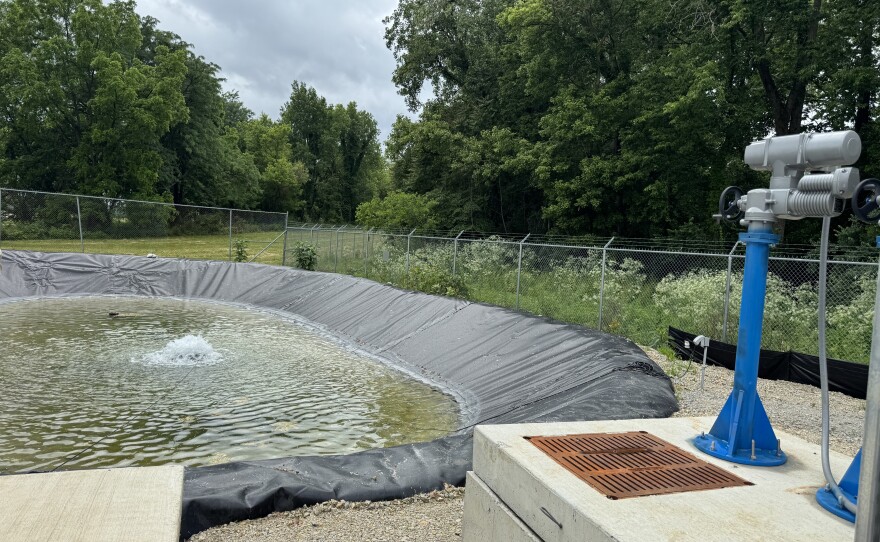Wright-Patterson Air Force Base is one of hundreds of military bases across the country working to comply with new drinking water standards and mitigate the spread of PFAS.
WYSO got a first-hand look at what systems they’re using to clean up the so-called forever chemicals.
PFAS are man-made compounds that research now links to cancer and other health effects. These compounds are incredibly difficult to break down, so the concern is that they’re making their way into the water and soil — and eventually drinking water wells.
That’s why regulators set maximum contaminant levels on these chemicals in drinking water and diverted some money to restoration of sites with this pollution last year.
Not only have PFAS been found in local communities like Dayton, 300 to 350 people actually live on the base, in addition to 38,000 employees reporting to work there each day.
Releases of PFAS accidental — and on purpose
These chemicals can be found in Wright-Patt’s water due to PFAS-containing firefighting foam (AFFF) used in training exercises since 1970. In some cases, even just having the foam on base resulted in the spread of these compounds.
The hazardous materials storage facility on base, for instance, had two accidental releases over a decade ago due to the malfunction of a fire suppression system, which contained some AFFF concentrate.
“That was prior to a lot of the known health risks,” said Greg Plamondon, remedial project manager at Wright-Patt. “They contained it as best they could with booms at the time. But again, it hit a concrete surface and just kind of moved off very quickly. And the residual, that's what we're dealing with now.”
The Air Force has been working on containing PFAS pollution since 2015, when the U.S. EPA first created non-enforceable, lifetime health advisories on the levels of the chemicals in drinking water.
On the Fairborn base, 24 people are in its environmental office, not including all the contractors that also work on PFAS mitigation and testing.
The base currently is or is planning to investigate 26 sites with known PFAS contamination — 25 on- and one off-base.
Wright-Patterson’s Environmental Branch Chief Raymond Baker said they’re looking for answers on the best method to treat each site.
“The purpose of this investigation is to determine the extent of the PFAS and then characterize the sites,” Baker said.
Treatment systems serve as test case for PFAS remediation in water
Two of those 26 sites have treatment systems installed to prevent contaminated water from spreading off base and affecting drinking water wells.
Construction Quality Control Manager Terry Bauer, who oversees these two treatment systems, said they’re unique and serve as a test case for any such system.
“We have a lot of folks interested in coming and looking at this facility. And we expect it's going to be a growth type of industry for quite a while,” Bauer said.
The treatment system in Area B, which was considered the highest priority site, takes the contaminated water through four stages.
The system’s redundancy was added in case any one of the stages went offline, according to Bauer.
The water that then flows off site near the Mad River, comes out in the “low single digits (of parts per trillion)…which is the limit that the laboratory can detect,” Bauer said.
Some treated water may be above maximum contaminant levels, but water actually distributed on base isn’t
The water supply on-base is also treated to pull out some of the PFAS molecules. The system is called granular activated carbon. It works as a filter.

American Water, which supplies the base’s drinking water, continues to use technology to find additional contaminants they can treat into the future, said Jeff Miller, vice president of operations.
“So we're continually researching, working with regulators to ensure that we're providing the most efficient safe drinking water that we can,” Miller said.
Previously WYSO reported that 2023 PFAS test results of its finished drinking water showed that two of its three water treatment plants, one in Area A and one in Area B, had levels exceeding upcoming maximum contaminant levels.
But Baker said the water distributed in Area A is blended so that what they distribute isn’t over maximum contaminant levels, according to Baker. And they’ve maintained that for years.
“We meet all the EPA regulations for the Safe Drinking Water Act,” he said.
Last month, the EPA’s new administrator announced plans to rescind maximum contaminant levels for four of the six regulated PFAS compounds while keeping limits for two of them, PFOA and PFOS, as well as extending the timeframe water systems have to comply.
John Crocker, another project remedial manager on-base, said they’ve seen the statement from the EPA, ”but that’s all we know.”
“So the statements that were made about rescinding limits and how PFOS and PFOA are regulated, that’s exactly what we heard," Crocker said. "We’re waiting until it becomes a legal change.”






